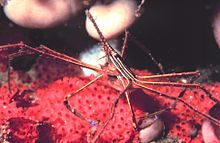Stenorhynchus seticornis
| Stenorhynchus seticornis | |
|---|---|

| |
| Scientific classification | |
| Domain: | Eukaryota |
| Kingdom: | Animalia |
| Phylum: | Arthropoda |
| Class: | Malacostraca |
| Order: | Decapoda |
| Suborder: | Pleocyemata |
| Infraorder: | Brachyura |
| Family: | Inachidae |
| Genus: | Stenorhynchus |
| Species: | S. seticornis
|
| Binomial name | |
| Stenorhynchus seticornis (Herbst, 1788)
| |
Stenorhynchus seticornis, the yellowline arrow crab or simply arrow crab, is a species of marine crab.
Taxonomy
Stenorhynchus seticornis was
Description

The body of S. seticornis is triangular, and the rostrum is drawn out into a long point with serrate edges.[3] The legs are also long and thin, up to 10 cm (3.9 in) across,[4] and the animal's carapace may be up to 6 cm (2.4 in) long.[5] Colouration is variable in this species; the body may be golden, yellow or cream, marked with brown, black or iridescent-blue lines; the legs are reddish or yellow, and the claws are blue or violet.[5] This species presents as diagnostic features: triangular body with long pointed snout (rostrum), carapace decorated with fine dark lines and claws often have violet tips. S. seticornis is most commonly associated with anemones, in groups ranging from one to six individuals in south-eastern Brazil.[6]
Distribution
Stenorhynchus seticornis is commonly found in the shallow sub-tidal on rock bottoms, corals, calcareous algae, and also on soft sediments, such as shelly gravel and sand. Its geographical distribution is restricted to the Occidental Atlantic, from North Carolina to Argentina.[7] Stenorhynchus seticornis is found in the western Atlantic Ocean, from North Carolina and Bermuda to Brazil, including throughout the Caribbean Sea,.[5] It lives on coral reefs at depths of 10–30 feet (3.0–9.1 m).[8]
Ecology and behaviour
S. seticornis is
S. seticornis is one of a number of different
Life cycle and reproduction
During
Breeding period
Climate majorly regulates the breeding period of the arrow crab. Seasonal variation of water temperature and sunlight duration are considered as the most important variables determining the breeding period of arrow crabs.[16]
There is a positive relationship between fecundity and the size of the parental female.[7] In fact, the size of the female is the key variable in determining the number of eggs per batch. The female also determines the reproductive output of arrow crabs.[17]
Larval stage
Larvae that have grown in shallow water differ from larvae that grow in deeper water. The key difference is in the setation of the endopodite of the maxilla.[18]
See also
References
- ^ Raffles Bulletin of Zoology. 17: 1–286.
- Bulletin of Zoological Nomenclature. 23 (1): 19–21. 1966.
- ISBN 978-0-486-42068-4.
- ISBN 978-0-9623389-4-6.
- ^ ISBN 978-0-618-00211-5.
- ^ ISSN 1755-2672.
- ^ S2CID 86505995.
- ^ Melissa Block (2001). "Stenorhynchus seticornis, yellowline arrow crab". Animal Diversity Web. University of Michigan. Retrieved October 6, 2010.
- ^ a b c d Emilio Barela. "Arrow crab". WhoZoo.org. Retrieved October 6, 2010.
- ^ ISBN 978-0-08-021548-8
- ^ "Arrow crab". aquariumslife.com. Retrieved February 8, 2011.
- ^ William Herrnkind; Gregg Stanton & Edwin Conklin (1976). "Initial characterization of the commensal complex associated with the anemone, Lebrunia danae, at Grand Bahama". Bulletin of Marine Science. 26 (1): 65–71.
- S2CID 250948106.
- PDFproofs) on 2017-08-15. Retrieved 2012-12-13.
- S2CID 90675584.
- S2CID 84753432.
- ISSN 1077-8306.
- ISSN 0011-216X.
External links
 Media related to Stenorhynchus seticornis at Wikimedia Commons
Media related to Stenorhynchus seticornis at Wikimedia Commons- Photos of Stenorhynchus seticornis on Sealife Collection
